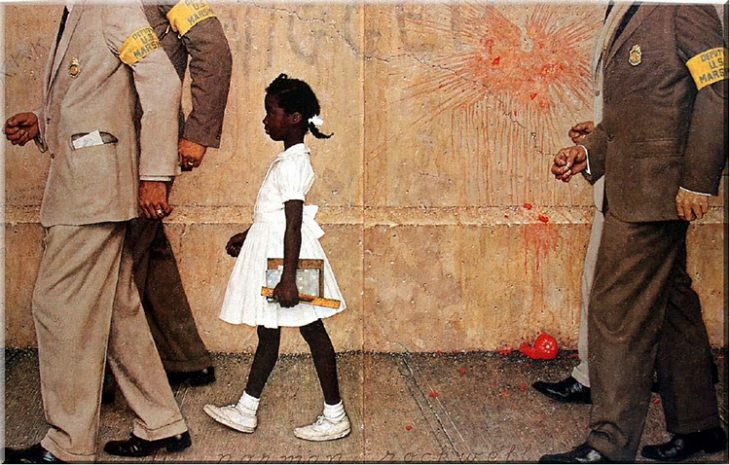We will now continue from Part 1 to Part 2 in our series about the history of systemic racism in America.
The Turning Point
That was America in 1960 — characterized by real systemic racism to the nation’s core.
The first real chink in the armor of that entrenched system occurred in 1954, when the Supreme Court outlawed segregation in public schools. Up to that time, the rule had been “separate but equal.” The states recognized the separate part of this equation, but gave the equal part little attention. Thus, schools for colored children were usually run down and poorly equipped.
It soon became very apparent that a court decision was worthless without enforcement follow-up. Thus, nine years later, in 1963, Governor George Wallace of Alabama was still proclaiming, “segregation now, segregation tomorrow, segregation forever.” Wallace backed up his words by standing in the door of a building at the University of Alabama campus in Tuscaloosa, refusing to allow two black students to enter. President Kennedy had to call out the National Guard to get the students in the school.
Praise God, the tumultuous decade of the 1960s would prove to be the real turning point in the fight against systemic racism in America. First came the Civil Rights Act of 1964 which outlawed racial discrimination in schools, employment and public accommodations. The bill had been proposed by President Kennedy, but he was unable to get it through Congress. His assassination in November of 1963 changed the political system. His successor, President Lyndon Johnson, called on the Congress to pass the bill as a memorial to Kennedy.
The Civil Rights Act was revolutionary, but its provisions concerning voting were very weak. For example, it did not eliminate literary tests. It just specified that all rules and regulations concerning voting had to be applied equally to all races. There was no recognition of a “right” to vote, and therefore the concept of qualifying to vote in some way was left in place.
This serious problem was addressed the next year in the Voting Rights Act of 1965. It guaranteed the right to vote to all racial minorities. Many legal experts consider this bill to be the most effective civil rights legislation ever enacted in the history of our nation. Its purpose was to enforce the rights guaranteed in the 14th and 15th Amendments of the Constitution. The 14th Amendment, adopted in 1868, guaranteed “equal protection under the law;” the 15th, adopted in 1870, prohibited states from denying the right to vote based on “race, color or previous condition of servitude.” Yes, these vital freedoms had been in our Constitution since the Civil War, but they had not been enforced.
The guarantee of the right to vote was the nail in the coffin of systemic racism. It would be only a matter of time before minorities of all colors would be elected to important public offices throughout our nation, culminating in the election of Barack Obama as President in 2008.

This stamp was issued by the U.S. Postal Office in 1999 to commemorate Dr. Martin Luther King, Jr.’s “I Have A Dream” Speech. (i-Stockphoto.com)
The Key Element
The key factor in accomplishing these major legal victories against racism was the Civil Rights Movement led by Dr. Martin Luther King, Jr. from 1955 to his death in 1968. He was an ordained Baptist preacher who believed very strongly in non-violence. He therefore advocated peaceful civil disobedience.
Yes, there was a lot of violence associated with his movement, but his protesters were not the source of the violence. Rather, the violence was directed toward them on the part of white racists. In fact, the willingness of his followers to be beaten in behalf of their beliefs, without retaliation, was what began to turn the tide of public opinion in America.
Luther’s movement climaxed on August 28, 1963 with a rally at the Lincoln Memorial in Washington, D.C. This was the historic occasion when he delivered his incredible, “I Have A Dream,” sermon. In that sermon, he presented his dream for an America of racial equality. Eight times he proclaimed, “I have a dream…” The most memorable was when he said:
I have a dream that my four little children will one day live in a nation where they will not be judged by the color of their skin but by the content of their character.
He concluded the sermon by saying that he was dreaming of the day when “all of God’s children, black men and white men, Jews and Gentiles, Protestants and Catholics, will be able to join hands and sing, in the words of the old Negro spiritual, ‘Free at last! Free at last! Thank God Almighty, we are free at last!'”
In the third and final part of our look at the history of systemic racism in the United States, we will note the death of systemic racism in the United States.








It would be helpful to point out the influence of radical black racism per Ferecom, and Black Panthers, Malcolm X, and current Communist groups as Black Lives Matter in the attitudes of the black communities and Progressiveism through the Democratic party.